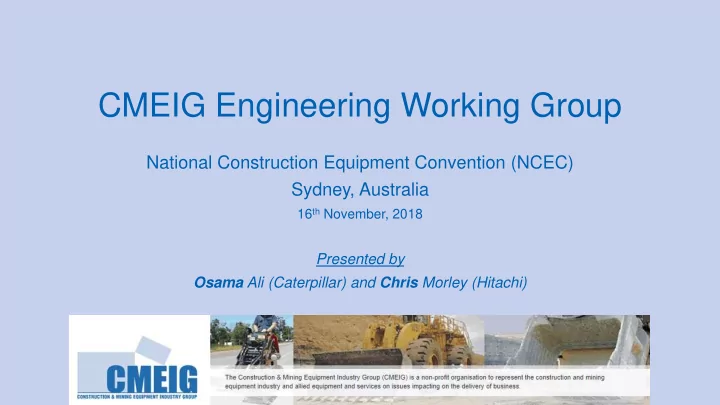

CMEIG Engineering Working Group National Construction Equipment Convention (NCEC) Sydney, Australia 16 th November, 2018 Presented by Osama Ali (Caterpillar) and Chris Morley (Hitachi)
Disclaimer: The Construction and Mining Equipment Industry Group (CMEIG) is a non-profit organisation sponsored by companies involved in the supply of products and services in the construction and mining equipment supply industry in Australia. This presentation has been prepared by members of CMEIG and is distributed by the Association. This information is provided for general reference only and no legal liability can be accepted by the Association or its members for its use. The views of any individual author of the information provided are not intended to represent the views of CMEIG or its members. CMEIG advises that you should seek appropriate specialist advice for your situation.
Agenda • EWG Introduction • Activity ‘snapshot’ • Standards Development Activities • Access systems • Rubber tired equipment, in-service brake testing • CMEIG Papers • Rated Load Measurement for Wheel Loaders • Rated Capacity Indicators for Tracked Excavators • Questions/Comments
Engineering Working Group • A ‘branch’ of CMEIG • Technical SME’s from various CMEIG members • Group aim: • Represent the industry on various committees & forums • Liaise with regulatory bodies in all States/Territories • Promote standards and regulations harmonisation • Advise on technical issues relating to construction and mining equipment • Publications, presentations, advisory documents, regulatory instruments • www.cmeig.com.au/working-groups/engineering
Standards Development Activities
Standards Development - Access Systems • EMM access to the operator station and routine maintenance • Handrails, Guardrails, Steps, Ladders, Doors, Openings etc. • Burning platform • Issue of varying sources of reference currently in Australia
Intent – Additional Clarity for Access Systems Design • Project underway to re-align and provide design clarity • 5- 6 Disparate references → 1 document • More detailed guidance in specific areas • Public comment Powered access Kick-rails Guardrail Height Definitions and Anti-vibration Clarifications 1 st Step Height Access Lighting
Standards Development - Brake Testing • Existing drivers (in specific applications) for in-service dynamic brake testing • Limited guidance • Extensive sources of real-world variability • Vague pass/fail criteria • Currently a work in progress • Re-alignment of similar AS and ISO standards • Practicable guidance for in-service brake testing • Objective pass/fail criteria
CMEIG Paper Measurement of Rated Load for Wheel Loaders
Different standards • No current Australian Standard for determining rated load for wheel loaders • Different international standards, eg.: • ISO 14397-1:2007 Earth-moving machinery - Loaders and backhoe loaders - Part 1: Calculation of rated operating capacity and test method for verifying calculated tipping load • ISO 20474-3:2017 Earth moving machinery – Safety – Part 3: Requirements for loaders • EN 474-3:2006 Earth-moving machinery – Safety – Part 3: Requirements for loaders • SAE J1197-2011 Rated Operating Load for Loaders Equipped with Log or Material Forks without Vertical Mast • (Withdrawn) SAE J818-2007 (Rated Operating Load for Loaders)
General Principles • Rated load usually determined by: m tip k × (tipping load*) (stability factor) *under certain conditions • Configuration most likely to tip • Include: • Mass of load and material density • Location of CofG • Mass of attachment and coupler • Variables and conditions, for example: • Ground condition (firm and level, rough terrain) • Maximum speed of travel • Tyre compressibility (rigid vs flexible)
Example – Fork Applications Standard Operating surface Factor Max. travel speed ISO 14397-1:2007 Hard substantially smooth and level 50% tipping load, or 15 km/h 100% hyd capacity ISO 20474-3:2017 Rough terrain 60% tipping load, or 15 km/h 100% of hyd capacity Firm and level ground 80% tipping load, or 15 km/h 100% of hyd capacity EN 474-3:2006 Rough terrain 60% tipping load, or 15 km/h 100% of hyd capacity Firm and level ground 80% tipping load, or 15 km/h 100% of hyd capacity SAE J1197-2011 Hard, moderately smooth and level 50% tipping load, or 6 km/h 100% hyd capacity
Specific Applications Addressed • Bucket applications • Fork applications • Log handling applications • Heavy single object • (non palletised) applications • Lifting freely suspended loads • ( Australian Standard exists )
Purpose of CMEIG Paper • Clarify main differences between main standards • Update on previous CMEIG advisory • Does NOT replace details contained in standards • Ready quick reference • Available on CMEIG website
CMEIG Paper Variable Load Lifting with Tracked Excavators
Variable Load Lifting – Tracked Excavators • Relates to lifting freely suspended loads as a secondary function associated with the normal THEX applications: • lifting and moving pipes • unloading construction equipment • manoeuvring accessories associated with the equipment
Burning Platform • Source of ongoing inquiries to CMEIG members • AS 1418.8, Section 5
How This Plays Out Today…
Purpose of CMEIG paper • Number of historical drivers for these differences in position • Advises on how new technologies can address some of these historical drivers • AU Approach inconsistent with ROW
Questions / Comments? • https://www.cmeig.com.au • Working Groups • Engineering
Recommend
More recommend